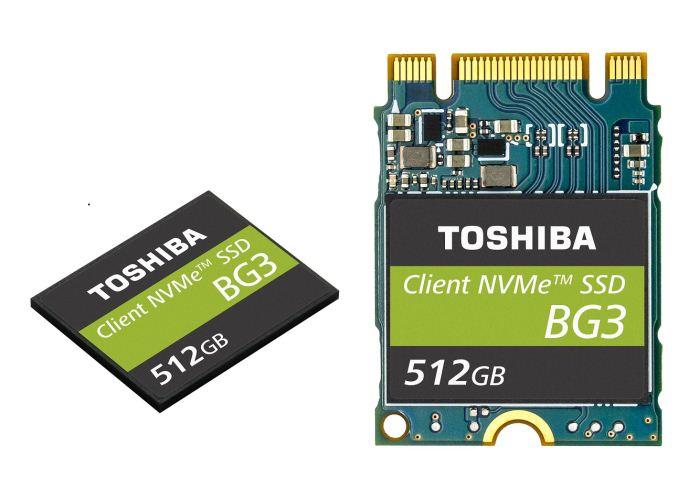Toshiba Announces BG3 Low-Power NVMe SSD With BiCS3 3D NAND
by Billy Tallis on August 3, 2017 9:01 AM EST
Toshiba's transition to their 64-layer 3D NAND flash memory continues predictably with today's launch of their third-generation BGA SSD, the BG3 series. First unveiled in 2015, Toshiba's family of BGA SSDs serves as their entry-level client OEM NVMe offering, with a focus on low power use and compact packaging rather than high performance. A year ago, Toshiba's BG series became their first client SSD to adopt their 3D NAND and it was one of only a handful of products to use their 48-layer BiCS2 3D NAND. This year, Toshiba finally has 3D NAND suitable for widespread adoption in their 64-layer BiCS3 3D NAND. The BG3 is their third SSD announced with the new 3D NAND, after the XG5 mainstream NVMe SSD for the OEM market and the TR200 retail SATA SSD. So far, all of Toshiba's 64-layer 3D NAND SSDs are using the 3-bit-per-cell TLC variant.
Aside from the update to the new generation of 3D NAND, little has changed with the BG series over the previous generation. The BG3 still uses the standard M.2 16x20mm BGA package with a PCIe 3 x2 link. As with the last generation, the BG3 is a DRAM-less SSD that supports the NVMe 1.2 Host Memory Buffer feature to mitigate the performance impact of not including DRAM on the SSD itself. The BG3 uses only about 38MB of the host system's RAM to cache mapping information about which logical block addresses are stored in which flash memory pages. That 38MB cache is sufficient to provide a substantial performance boost for workloads with a working set in the 2GB to 16GB range, with Toshiba citing improvements of 80% to 150% for random accesses at high queue depths.
The BG3 will be available in the same three capacities from 128GB to 512GB, but the packaging has been slimmed slightly: the smaller two models are now 1.3mm thick instead of 1.4mm, and the 512GB model is now 1.5mm instead of 1.65mm. The BG3 will also be available mounted on a removable single-sided M.2 2230 card. The BG3 is rated for up to 1520 MB/s for sequential reads and 840MB/s for sequential writes, with a maximum power draw of 3.2W and a typical active power of 2.7W. As with all of their OEM SSDs, Toshiba is not disclosing exact pricing, but they say it is comparable to SATA drives. The BG3 is currently sampling to OEMs and will be on display at Flash Memory Summit next week.
Toshiba plans to continue transitioning to 64-layer 3D NAND in every segment of the SSD market. The OEM counterpart to the TR200 SATA SSD will be the Toshiba SG6, which will complete their client OEM lineup. We expect retail NVMe products to be announced later this year.










6 Comments
View All Comments
BillBear - Thursday, August 3, 2017 - link
Even if it isn't high performance for an NVMe SSD, I still find the size of that form factor amazing, however, I am old enough to remember 8 inch floppys.abrowne1993 - Thursday, August 3, 2017 - link
If the floppy is 8 inches I'd hate to see the hard disk.Stan11003 - Thursday, August 3, 2017 - link
https://www-03.ibm.com/ibm/history/exhibits/storag...They were the size of a mini fridge and cost up to $87K
edzieba - Friday, August 4, 2017 - link
Gotta be careful with data access on those: if you were bored (or malicious), you could read/write data alternately on the inside and outside tracks of the platters, causing the (comparatively) massive R/W head arm to swing rapidly back and forth, and the whole unit could start to walk away on you.bill.rookard - Thursday, August 3, 2017 - link
The thing that would worry me, and I wonder if anyone thought this through....If it uses system RAM for hosting the mapping info for the LBA -> page map... what happens if the system:
1) isn't using ECC and there's a bit error.
2) has a typical misbehaving program which corrupts the LBA mapping.
3) has a deliberately malicious program muck with the LBA mapping.
4) loses power during a write.
Any one of those three issues could create big problems with the drives and the stability of the system.
Billy Tallis - Thursday, August 3, 2017 - link
The host memory buffer memory is supposed to be set aside by the OS for the exclusive use of the SSD, so cases 2 and 3 would require an OS/driver bug, not just a misbehaving application. (Or a successful DRAM rowhammer attack.)Any SSD using HMB must be prepared to immediately relinquish that memory back to the host system, so in practice HMB is used as a write-through cache, not a write-back cache. That means there's nothing worse about a sudden power loss when you're using HMB.
Lack of ECC is theoretically a problem, but given the small amount of DRAM used for HMB, the expected error rate is really small and not a concern for most of the applications that would use this kind of SSD.